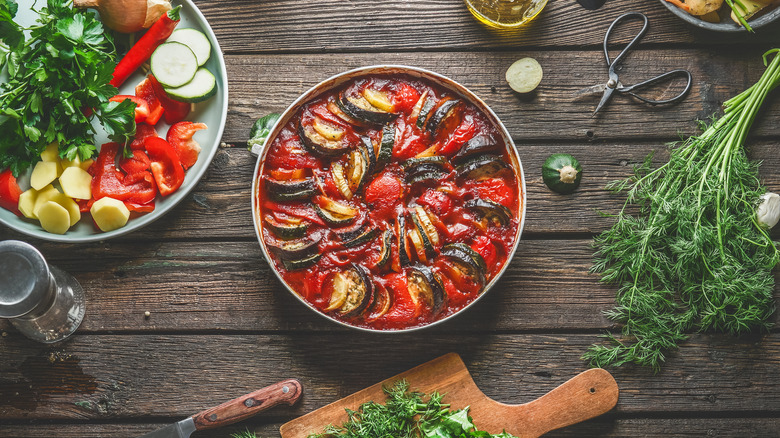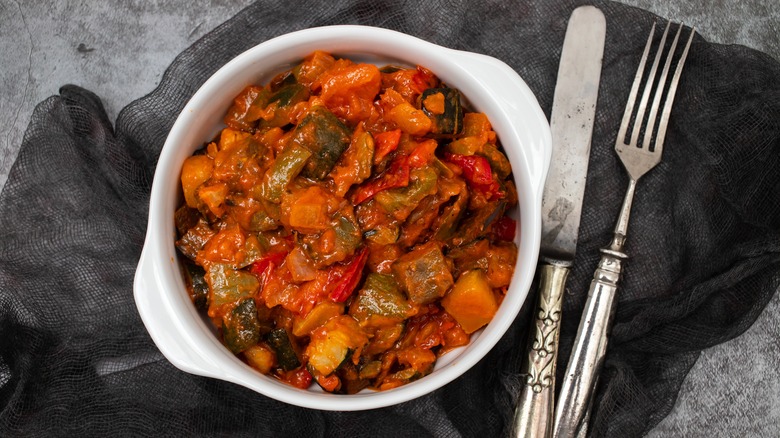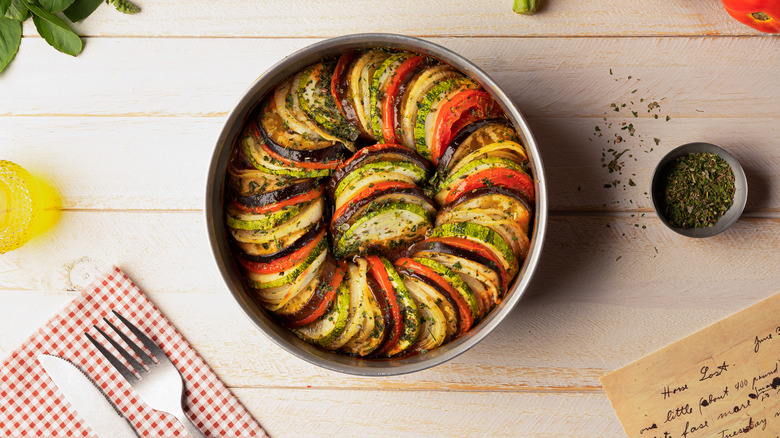The Little-Known Origins Of The Iconic French Ratatouille
If you're familiar with ratatouille thanks to the Pixar film of the same name, the image that probably comes to mind is a dish made from rounds of vegetables, carefully cut and layered into a colorful dish that you can tell is just delicious. That's actually not what a classic ratatouille is, and instead, the dish has more often been made by slicing vegetables into cubes before simmering it into a stew. That's not entirely surprising when you consider that when and where the dish originated, cooks were more concerned with making a hearty meal where nothing was wasted, rather than focusing on how visually appealing it could be.
It's not known precisely when ratatouille first became popular, but we do know that the first time it appeared as a written recipe was 1877 — and then, it was described as a meat-heavy stew. "Ratatouille" didn't come to mean the dish we think of today until around the 1930s, but it's believed that the dish itself had been popular since at least the 1700s. That's just the dish's confirmed history, and it makes sense that it was a dish that was made long before then.
It was, after all, simply a dish made with leftover vegetables and favored by peasants farming in southern France — specifically, in Nice. Interestingly, it's the same area of the world that gave us other foods, like aioli, bouillabaisse, and the nicoise salad. How did it go from farm-fresh favorite to the trendy dish we see today?
Ratatouille went from a rural staple to restaurant feature
Firstly, it's worth noting that there's a little bit of debate on who made ratatouille first. That's not entirely surprising, as it originated as a pretty straightforward vegetable stew. Similar stews were common in some areas of Spain as well as in France, and it was particularly popular at the end of the harvest season. That's when all the summer vegetables would need to be used, and it was also a brilliant way to use overripe ingredients in a way that was still tasty, delicious, and hearty.
The name "ratatouille" comes from the combination of two French words: "ratouiller" means "to stir," and "tatouiller" means "to beat." (Fun fact: The latter is the same word we get "tattoo" from.) It's a reference to how the dish is made, starting with the chopping of vegetables, then the long process of stirring the stew as it simmered.
Ratatouille, it seems, started to spread outside of its native France post-World War II. That was the era when French cuisine was at a high, both in the greater context of Europe and the U.S. It was introduced to Americans in the 1950s, at the same time that travelers sampled — and returned home with a desire for — foods like crêpes, quiche, and nicoise salads.
Ratatouille went from peasant fare to haute cuisine
There's an interesting thing that happened with ratatouille, and it's similar to the story other French dishes — like beef bourguignon and coq au vin — which got their start as humble dishes meant to make the most of ingredients that were often difficult to cook. Today, these foods have been elevated into delicacies, in large part due to the time, effort, and knowledge it takes to get them right.
That happened with ratatouille in a big way thanks to Pixar and their film of the same name. Pixar's team not only took cooking classes and shadowed kitchen staff at French restaurants, but they also consulted with Chef Thomas Keller. Keller — and other consulting chefs — created dishes for the film as they would have created them for their own restaurants, and ratatouille got the Michelin-star style treatment, too. Keller's version was called confit byaldi, and in an interview with The New York Times, he explained, "We had to think about what would make the food transformed. What would transport [restaurant critic Anton Ego] back to his childhood in a Proustian sort of way."
Keller said that he landed on the ratatouille that made it into the movie in a flash of inspiration, which is pretty wild. Today, it means that you can absolutely make Remy's classic French ratatouille at home ... even if it's been vastly changed along the course of its history.


